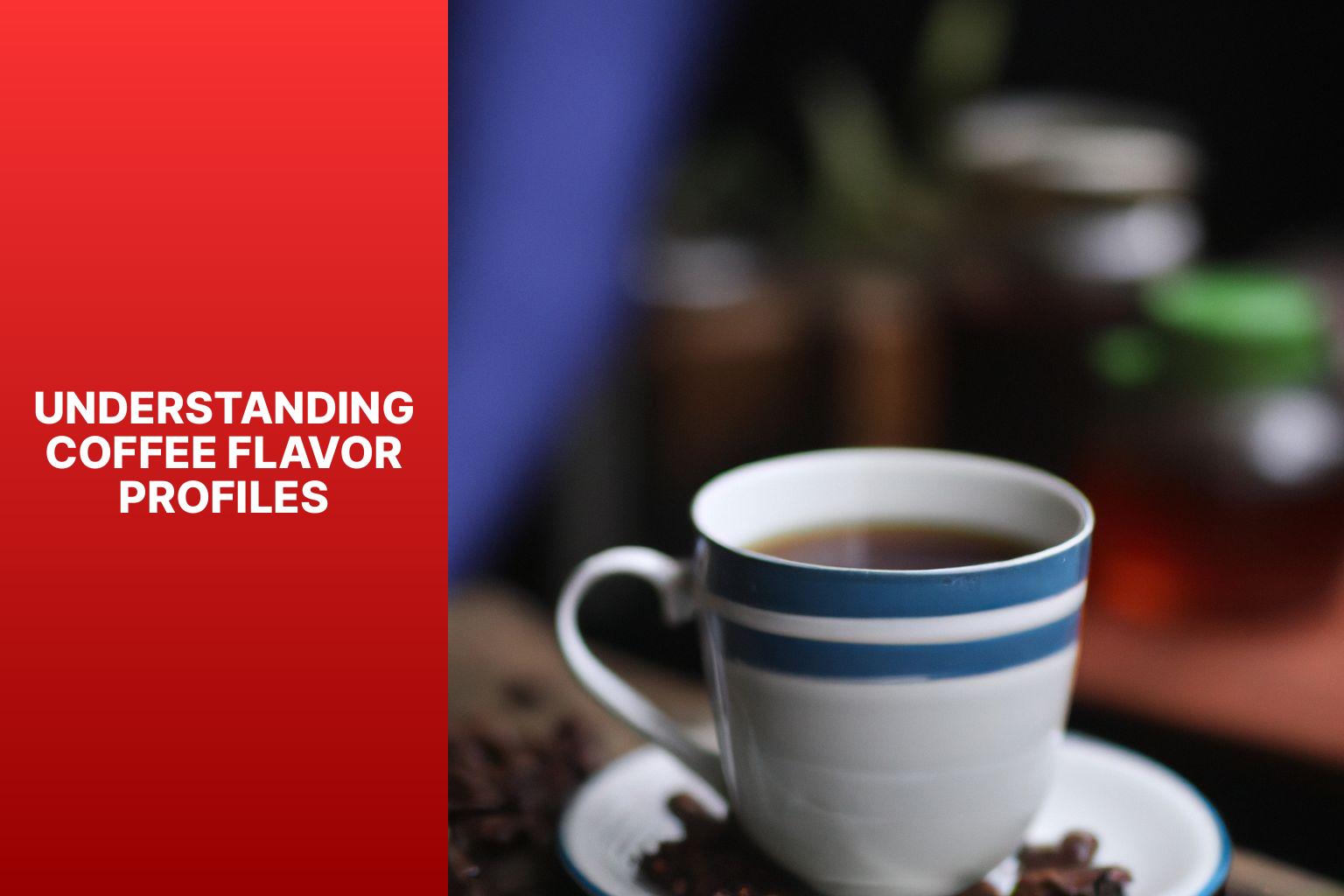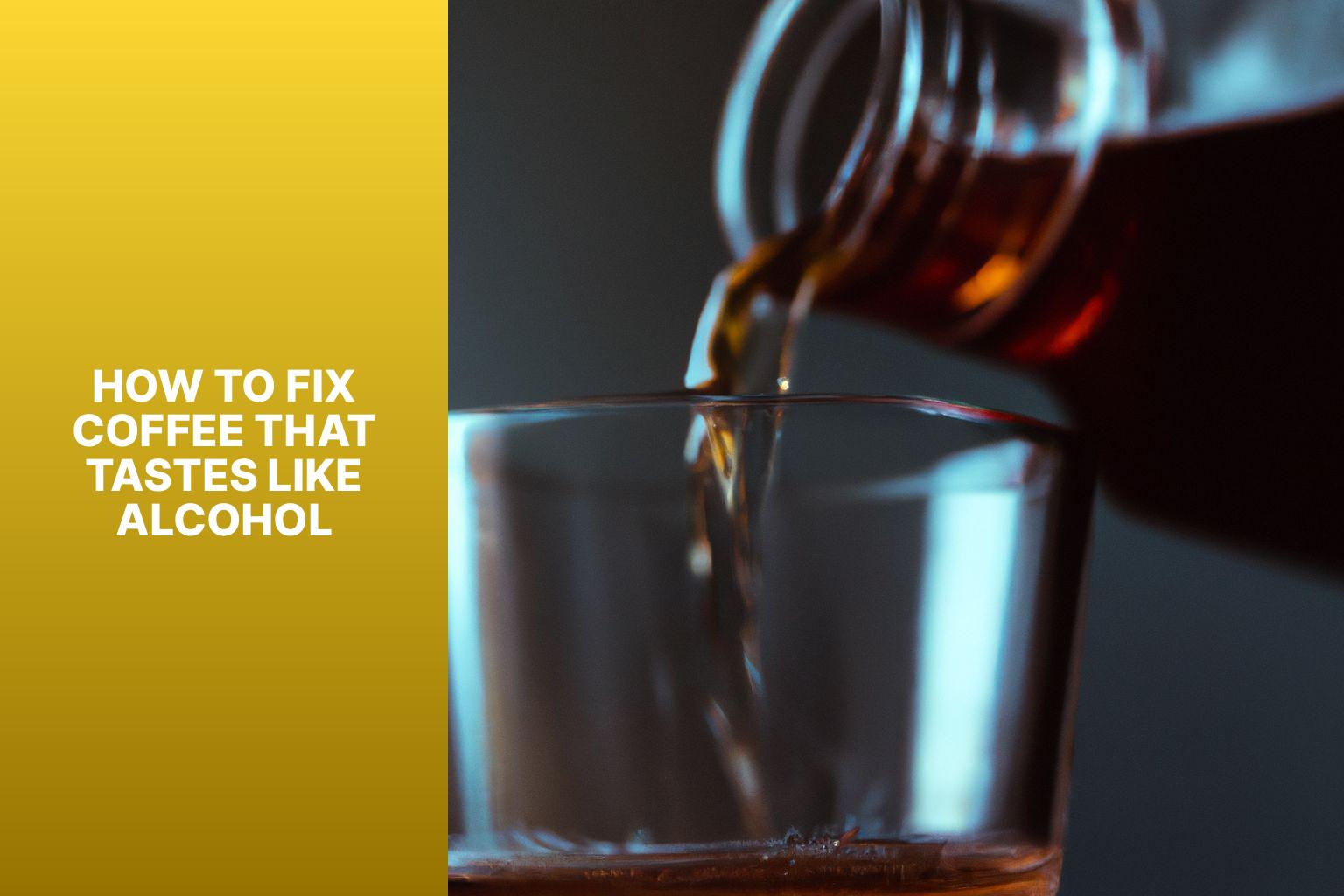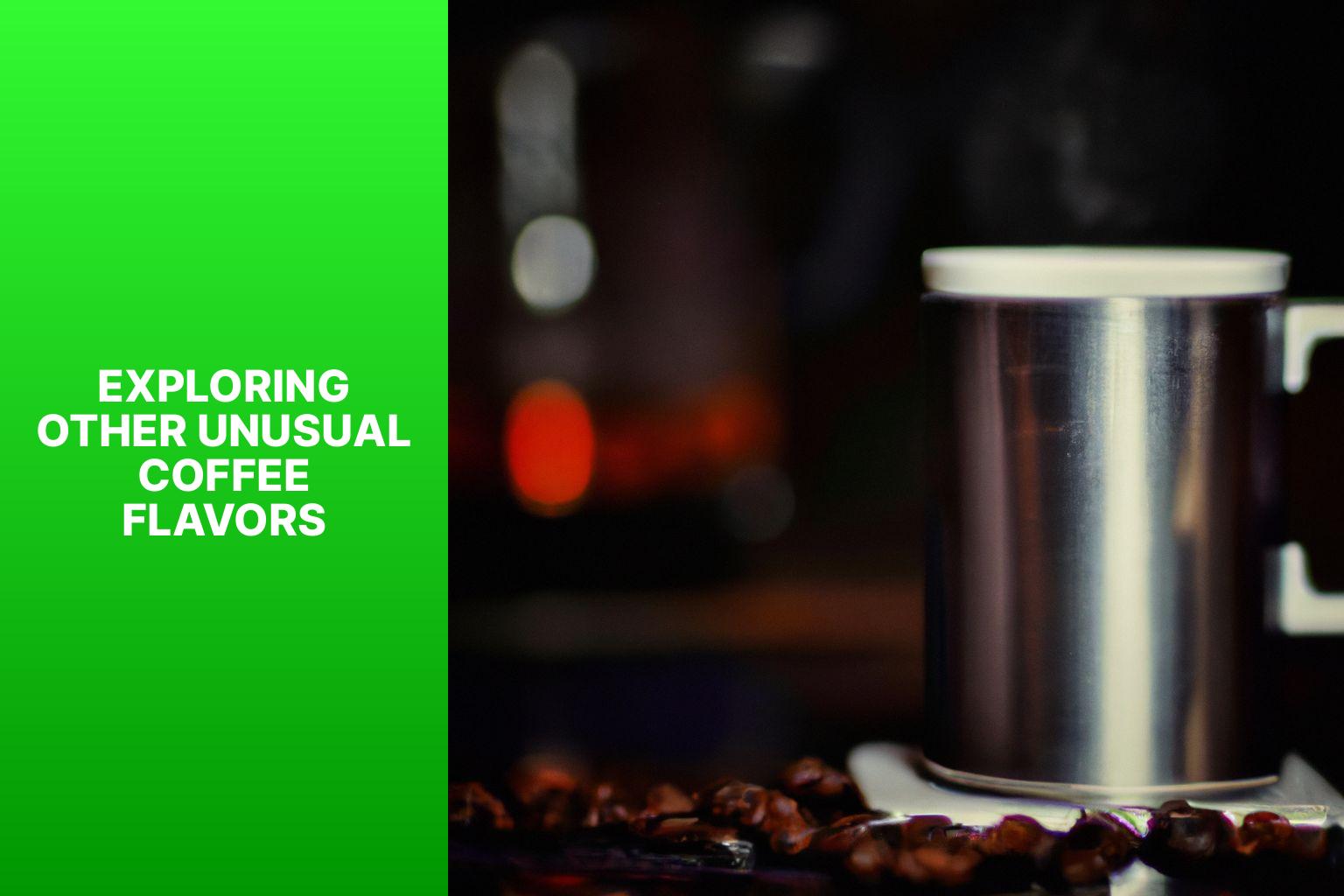Coffee is a beloved beverage enjoyed by millions around the world. It can sometimes exhibit unexpected flavors that leave you puzzled. One particularly perplexing taste that coffee drinkers encounter is a resemblance to alcohol. Unraveling this flavor mystery involves understanding the complexities of coffee flavor profiles and exploring the potential reasons behind coffee tasting like alcohol. This information can not only help you prevent coffee from acquiring an alcoholic taste but also assist you in fixing it if it does. we will delve into other unusual coffee flavors to expand your knowledge and appreciation of the diverse sensory experiences coffee can offer. Understanding the intricacies of coffee flavors allows you to enjoy your cup of java to the fullest and explore the fascinating world of coffee tasting.
Understanding Coffee Flavor Profiles

Photo Credits: Theimperfectcafe.Com by Austin Davis
Unravel the mysteries behind the flavors of your favorite coffee in the “Understanding Coffee Flavor Profiles” section. Discover the factors that influence the taste of your brew and explore common flavor descriptors that experts use to characterize different coffees. Get ready to dive deep into the world of coffee flavors and gain a better understanding of why your morning cup might sometimes taste like a hint of alcohol.
Factors Affecting Coffee Flavor
| 1. Coffee Bean Varieties | The flavor profile of coffee is influenced by the type of coffee bean used. Different coffee bean varieties create distinct flavors. For example, Arabica beans have fruity and acidic notes, while Robusta beans have bold and robust flavors. |
| 2. Growing Conditions | Environmental factors such as altitude, temperature, soil composition, and rainfall greatly impact the flavor of coffee beans. Coffee beans grown at higher altitudes and in cooler temperatures often have a more complex flavor profile. |
| 3. Processing Methods | The flavor of coffee beans can be influenced by the processing methods used after harvesting. For instance, the dry processing method, where coffee cherries dry with their pulp intact, can result in fruity and wine-like flavors. On the other hand, the wet processing method, which involves removing the pulp before drying, produces cleaner and brighter flavors. |
| 4. Roasting Techniques | The flavor of coffee is significantly affected by the roast degree and techniques used during roasting. Lighter roasts bring out nuanced and delicate flavors, while darker roasts develop bold flavors with hints of caramelization and bitterness. |
| 5. Brewing Methods | Brewing methods also play a crucial role in coffee flavor. Factors such as water temperature, brewing time, grind size, and brewing equipment all influence the final taste. Each brewing method has its own characteristics, resulting in different flavor profiles. |
Common Flavor Descriptors in Coffee
Coffee has a wide range of flavor descriptors that can help coffee enthusiasts understand and appreciate the various tastes and aromas it has to offer. If you are interested in exploring the world of coffee, here are some common flavor descriptors to be aware of:
- Earthy: If you come across coffee with earthy flavor notes, expect it to taste like soil, mushrooms, or wood.
- Chocolatey: Describing the rich and smooth taste of chocolate, this flavor descriptor is often used to depict certain coffee types.
- Nutty: Coffee with nutty flavors may exhibit hints of almonds, hazelnuts, or walnuts, adding a delightful twist to your coffee experience.
- Citrusy: For those who prefer bright and acidic flavors, a cup of citrusy coffee can provide notes reminiscent of lemon, orange, or grapefruit.
- Caramel: If you have a sweet tooth, caramel-flavored coffee could be the perfect choice. With its smooth and slightly buttery taste, it often brings to mind the satisfaction of biting into a caramel candy.
- Floral: Capturing the delicate fragrance and taste of flowers like jasmine or lavender, coffee with floral notes can transport you to a serene floral garden.
- Spicy: If you enjoy a bit of warmth and complexity in your coffee, try opting for one with spicy flavors like cinnamon, cloves, or nutmeg. It can surely awaken your senses.
- Berry: Adding a fruity and tart taste to your cup, coffee with berry flavors may offer delightful hints of strawberries, blueberries, or raspberries.
- Vanilla: For a touch of sweetness and creaminess, go for vanilla-flavored coffee. It brings to mind the flavors of vanilla beans or vanilla extract and offers a satisfying experience.
- Caramel: Caramel-flavored coffee can’t be missed on this list. With its sweet, smooth, and slightly buttery taste, it is indeed reminiscent of caramel candies.
- Roasted: The process of roasting coffee beans adds bold, smoky, and sometimes charred flavors to the coffee, creating a distinct and rich profile.
So, as you dive into the world of coffee, keep these common flavor descriptors in mind to enhance your understanding and appreciation of the diverse coffee offerings available. Enjoy exploring and savoring the wonderful world of coffee flavors!
From fermentation during processing to contamination from alcohol residue, find out the surprising reasons why your coffee may taste like alcohol.
Reasons for Coffee Tasting Like Alcohol
If you’ve ever sipped your morning coffee only to be puzzled by a distinct alcoholic flavor, you’re not alone. In this section, we’ll uncover the reasons behind this curious phenomenon. From the fermentation that occurs during coffee processing to potential contamination from alcohol residue, we’ll explore the factors that can contribute to that unexpected boozy taste. We’ll also delve into the intricate dance between the roasting process and chemical reactions that may further enhance or alter the flavor profile of your favorite brew. Get ready to unravel the mysteries behind your buzz-worthy cup of joe!
Fermentation during Processing
During the coffee processing, fermentation plays a crucial role in developing the flavor profile. Fermentation occurs when the cherries are harvested, and the fruit flesh is removed, which exposes the beans. This process enables the enzymes to break down sugars and release compounds that contribute to the unique flavors of coffee.
Factors such as duration and temperature have a significant influence on fermentation. Longer durations can result in flavors that are pronounced, resembling fruitiness or wines, while shorter durations produce flavors that are milder and more balanced.
Fermentation during the process is impacted by different microorganisms. Strains of yeast and bacteria produce a range of flavor compounds, including fruity and floral notes, as well as complex flavors.
Controlling the fermentation process is vital in achieving the desired flavor profile. By monitoring the temperature, time, and microbial activity, consistency can be ensured, and the occurrence of off-flavors can be prevented.
Your coffee isn’t having a wild night out, it just picked up some questionable residue along the way.
Contamination from Alcohol Residue
Contamination from alcohol residue in coffee can occur due to various reasons. One possibility is contact with alcohol during transportation, storage, or packaging. Another reason is improper cleaning of coffee equipment after contact with alcohol.
To prevent contamination from alcohol residue and maintain the quality of your coffee, it is important to choose reputable coffee suppliers and store your coffee beans in a clean, dry environment.
If you happen to encounter coffee with an alcohol-like taste, you can try diluting it or adjusting the coffee-to-water ratios. Experimenting with flavor enhancers or different brewing methods might also help alter the taste.
It is a known fact that alcohol residue significantly impacts the flavor of coffee. Therefore, implementing preventive measures and practicing proper cleaning procedures is essential to ensure the purity and integrity of both the coffee beans and the final brewed cup.
Roasting coffee is like a mad scientist’s experiment, with chemical reactions turning innocent beans into a bold, boozy brew.
Roasting Process and Chemical Reactions
During the roasting process, chemical reactions occur in coffee beans, contributing to the flavor profile. The Roasting Process exposes the beans to high temperatures, causing Chemical Reactions to take place. Maillard reactions occur between amino acids and sugars during the Roasting Process, resulting in the development of rich and complex flavors.
Roasting also breaks down organic compounds such as carbohydrates and proteins, generating aroma and taste characteristics associated with different roast levels. The Roasting Process affects the flavor by breaking down organic compounds. Lighter roasts have brighter and more acidic flavors, while darker roasts have bittersweet and smoky notes.
The Roasting Process influences the formation of volatile compounds, responsible for the aromas in coffee. These compounds develop as the beans are heated during the Roasting Process, contributing to the overall sensory experience.
It’s important to note that the duration and temperature of the Roasting Process greatly impact the final flavor of the coffee. Shorter roasting times at lower temperatures may result in a delicate and nuanced flavor profile, while longer roasting times at higher temperatures can produce bolder and more robust flavors.
Understanding the Roasting Process and its Chemical Reactions helps coffee enthusiasts appreciate the complexity of different coffee flavors. By experimenting with different roast levels and understanding the variables involved, individuals can find the perfect balance of flavors that suit their preferences.
Keep your coffee sober and free from alcohol by choosing high-quality beans, storing them properly, and mastering the art of brewing.
How to Prevent Coffee from Tasting Like Alcohol

Photo Credits: Theimperfectcafe.Com by Lawrence Hernandez
Discover the secrets to maintaining the perfect cup of coffee without any unwanted alcoholic aftertaste. From selecting the finest coffee beans to storing them correctly and mastering the ideal brewing techniques, this section will guide you through the steps necessary to prevent your beloved coffee from acquiring that peculiar alcoholic flavor. Say goodbye to unpleasant surprises and hello to a consistently delightful coffee experience. Brew with confidence and savor every sip!
Choosing High-Quality Coffee Beans
When selecting high-quality coffee beans, it is important to take into account a few key factors:
- Bean Origin: It is advisable to go for beans originating from esteemed coffee-growing regions such as Ethiopia, Colombia, or Brazil.
- Roast Level: Determine the roast level that best suits your taste preferences. Lighter roasts bring out the unique flavors, while darker roasts offer a more intense and full-bodied flavor profile.
- Freshness: Opt for freshly roasted beans, as they reach their peak flavor within two to four weeks after being roasted. Look for the roast date indicated on the packaging.
- Bean Variety: Consider exploring diverse varieties like Arabica or Robusta. Arabica beans generally deliver a smoother and more nuanced flavor.
- Sustainable and Fair Trade Practices: Make a conscious choice by selecting coffee beans that are ethically sourced and support sustainable farming methods. Look for certifications such as Fair Trade or Rainforest Alliance.
By carefully considering these factors, you will be able to ensure that you choose high-quality coffee beans that will result in a delicious and satisfying cup of coffee.
Keep your coffee beans stored properly, unless you enjoy the complex flavors of a coffee that’s been on a wild bender.
Proper Storage of Coffee Beans
Proper storage of coffee beans is crucial to maintain their freshness and flavor. Here are some tips to ensure proper storage:
1. Use an airtight container: It is important to store coffee beans in glass or ceramic containers. Plastic or metal containers should be avoided to prevent any alteration in flavor.
2. Keep them cool and dry: Coffee beans should be stored in a cool and dry place, away from any heat sources such as stoves or ovens. Moisture can negatively affect the flavor, so ensuring a dry storage area is essential.
3. Avoid sunlight: Sunlight can quickly deteriorate the quality of coffee beans. It is best to store them in a dark place or use a container that blocks light.
4. Don’t refrigerate or freeze: Storing coffee beans in the refrigerator or freezer is not recommended. Moisture and odors from other food items can seep into the beans, affecting their flavor.
5. Grind before brewing: To preserve the freshness and aroma, it is advised to grind the beans just before brewing. This helps in retaining the flavors and prevents any alcohol-like taste.
Fact: When properly stored, coffee beans can maintain their freshness and flavor for up to two weeks, ensuring a delightful cup of coffee every time.
Unlock the true potential of your brew with these expert-approved brewing techniques.
Appropriate Brewing Techniques
Appropriate brewing techniques are essential for achieving the desired coffee flavor and aroma. When it comes to achieving optimal extraction, certain factors must be considered.
One important factor is the grind size. Using the correct grind size is crucial. For espresso machines, finer grinds are suitable, while coarser grinds work better for French press or cold brew methods.
Another factor to consider is water temperature. The water should be between 195°F and 205°F (90°C – 96°C) for the best extraction. Using boiling water can result in scorching the coffee, while water that is too cool won’t properly extract the flavors.
Brewing time also plays a role in achieving balanced flavors. The brewing time may vary depending on the method used. For example, a shorter brewing time of 4-5 minutes for pour-over or 25-30 seconds for espresso can help achieve a well-balanced flavor.
The water-to-coffee ratio is another important aspect to keep in mind. The ratio of water to coffee affects the strength and concentration of the brew. Generally, a ratio of 1:15 (1 part coffee to 15 parts water) provides a well-balanced cup, but adjustments can be made based on personal preference.
The choice of filter can also impact the coffee flavor. Paper filters absorb oils, resulting in a cleaner taste, while metal filters produce a bolder brew with more body.
The type of brewing equipment used, such as a drip coffee maker, French press, or espresso machine, can influence the taste of the coffee. Each method has its own advantages and unique flavor profiles.
By paying attention to these appropriate brewing techniques, you can enhance the flavor of your coffee and enjoy a delicious cup that is tailored to your preferences.
Tired of feeling like you need to carry a flask with your morning brew? Here’s how to fix that alcoholic coffee without a trip to rehab.
How to Fix Coffee That Tastes Like Alcohol

Photo Credits: Theimperfectcafe.Com by Gregory Gonzalez
Are you struggling with a cup of coffee that tastes bizarrely like alcohol? Don’t worry, we’ve got you covered! In this section, we’ll explore effective solutions to fix your boozy-tasting brew. From the art of dilution and adjusting ratios to adding flavor enhancers and experimenting with different brew methods, we’ll uncover the secrets to transforming your coffee back into the rich, aromatic delight you know and love. Get ready to savor every sip without any unwanted surprises!
Dilution and Adjusting Ratios
To fix coffee that tastes like alcohol, focus on dilution and adjusting ratios. Dilution means adding water to decrease strength and alcohol-like taste. Adjusting ratios involves changing coffee grounds to water proportions.
To effectively dilute coffee and adjust ratios, follow these steps:
1. Measure coffee grounds and water accurately. Use a trusted coffee-to-water ratio, like 1:16 (one part coffee to sixteen parts water).
2. If your coffee tastes like alcohol, you may have used too much coffee or too little water. Dilute the coffee by adding a small amount of hot water to your cup until the desired taste is achieved. Avoid adding too much water, as it may weaken the flavor too much.
3. Adjust ratios by changing the amount of coffee grounds. If your coffee is too strong and tastes like alcohol, use fewer coffee grounds and the same amount of water. If the coffee tastes weak, increase the coffee grounds while keeping the water constant.
By effectively diluting coffee and adjusting ratios, you can balance the flavor profile and eliminate the alcohol-like taste. Experiment with different ratios to find your preferred taste.
True story: Once, I made a bitter-tasting coffee that resembled alcohol. Confused, I researched solutions. Following the advice of dilution and adjusting ratios, I added a small amount of hot water to my cup, reducing the bitterness significantly. This simple act transformed my unpleasant coffee into a perfectly balanced brew. Since then, I always remember the importance of diluting and adjusting ratios for desired coffee flavor.
Adding Flavor Enhancers
When adding flavor enhancers to your coffee, consider the following options:
- Syrups: Vanilla, caramel, or hazelnut syrups can add a sweet flavor to your coffee. Start by incorporating a small amount and adjust to taste.
- Spices: Experiment with different combinations of cinnamon, nutmeg, or cardamom to give your coffee a warm and aromatic twist.
- Flavored creamers: Enhance the creaminess and flavor of your coffee with mocha, peppermint, or Irish cream flavored creamers.
- Extracts: For concentrated bursts of flavor without extra sweetness, try adding a few drops of almond, mint, or coconut extracts to your coffee.
- Flavored powders: Cocoa or matcha powders can easily dissolve and add unique flavor profiles to your favorite brew.
- Whipped cream and toppings: Add a visual appeal and extra flavor to your coffee by topping it with whipped cream, chocolate shavings, or sprinkles.
Remember to start with small amounts and adjust the flavor enhancers to match your personal preference. Don’t be afraid to experiment with different combinations to enhance your coffee experience.
Brewing coffee is like a science experiment that sometimes ends with a delightful surprise or a disastrous explosion.
Experimenting with Different Brew Methods
– Adjust brewing time: Experiment with different durations. Shorter times may result in a milder flavor, while longer times can produce a bolder taste.
– Vary water temperature: Try different temperatures when brewing. Higher temperatures may extract more flavor, while lower temperatures can result in a smoother, less bitter taste.
– Change grind size: Adjust the size of coffee grounds based on your preferred brewing method. Finer grounds are used for espresso, while coarser grounds are ideal for French press. Different grind sizes can affect the extraction process and flavor.
– Experiment with different brewing methods: Explore pour-over, French press, AeroPress, or cold brew. Each method offers a unique flavor experience and allows you to customize the strength and taste of your coffee.
– Try different coffee-to-water ratios: Adjust the ratio of coffee to water to find the perfect balance for your taste. Increasing the amount of coffee grounds can result in a stronger brew, while using less coffee will produce a milder flavor.
– Explore alternative brewing equipment: Consider using alternative brewing equipment like a Chemex, Moka pot, or Vietnamese coffee filter. Each method can bring out different flavors in the coffee and offer a new experience for your taste buds.
– Experiment with coffee origins and roast levels: Different origins and roast levels greatly influence the flavor profile. Try single-origin coffees from different regions or experiment with light, medium, and dark roasts to discover the flavors that suit your palate.
Exploring Other Unusual Coffee Flavors: Prepare to be pleasantly surprised or mildly horrified by earthy, sour, or metallic notes in your cup of joe.
Exploring Other Unusual Coffee Flavors

Photo Credits: Theimperfectcafe.Com by Kyle Roberts
Unveiling new and intriguing dimensions of coffee flavors, we now venture into the realm of unusual taste profiles. Get ready to delve into the peculiar world of coffee as we explore earthy or mushroom-like flavors, sour or acrid tastes, and metallic or chemical notes. Prepare to be amazed by the diverse and unexpected sensations that can emerge from your morning cup of java. Let’s unlock the mysteries behind these distinctive flavors and broaden our coffee tasting horizons.
Earthy or Mushroom-like Flavors
Earthy or mushroom-like flavors in coffee can be off-putting for some, but others find them intriguing and enjoyable. These flavors result from compounds in coffee beans and are influenced by factors such as origin, processing methods, and roast level.
1. Origin: Coffees from regions like Ethiopia or Sumatra are known for their earthy notes. Soil and climate conditions in these areas contribute to the development of these flavors.
2. Processing: Natural or unwashed processing methods, where beans dry with the fruit intact, can enhance earthy flavors. The fermentation process during drying brings out these characteristics.
3. Roast level: Darker roasts intensify earthy flavors. Longer and hotter roasting develops deeper, earthy flavors.
To prevent or reduce earthy flavors, try beans from regions known for brighter or fruitier flavors. Lighter roasts with shorter roast times help minimize these flavors.
Pro-tip: If you enjoy earthy flavors, try different brewing methods and ratios. French press or cold brew accentuate these flavors for a pronounced earthy experience.
Get ready to pucker up as we delve into the tangy world of sour and acrid coffee flavors.
Sour or Acrid Tastes
Various factors can contribute to the development of sour or acrid tastes in coffee, which can greatly affect its overall flavor. One of these factors is the acidity level found in the coffee beans themselves. This acidity level can be influenced by several different aspects, such as the type of bean used, the specific region where it is grown, and even the altitude of the plantation. When the acidity level is too high, it can result in a sour taste.
Another reason for the presence of sour flavors in coffee is over-extraction during the brewing process. This can occur when the coffee is brewed for too long or when water at a high temperature is used. Both of these factors can contribute to an undesirable sour taste.
Additionally, poor-quality or stale coffee can develop sour or acrid flavors due to improper storage methods. It is important to store coffee properly to ensure its freshness and maintain its desired taste.
Furthermore, grinding coffee beans too finely can lead to over-extraction, releasing sour compounds into the final cup of coffee. It is crucial to grind the beans to the appropriate consistency to avoid this issue.
In some cases, sour or acrid tastes can be an indication of brewing problems or equipment issues. For example, using dirty equipment or experiencing uneven extraction can result in these unpleasant flavors.
In today’s coffee culture, sour or acrid flavors are considered undesirable. Coffee farmers and roasters have put in a lot of effort to cultivate beans with balanced acidity levels. As a result, it is now possible to enjoy a well-balanced cup of coffee that is free from any sour or acrid notes.
To achieve this ideal flavor profile, it is necessary to follow proper brewing techniques, use high-quality beans, and ensure freshness and proper storage. By doing so, you can experience the delightful flavors and aromas of a perfectly balanced cup of coffee.
Metallic or Chemical Notes
Coffee can sometimes have metallic or chemical notes, which can be unappealing. Here are some reasons for these flavors and how to address them:
- Roasting process: If coffee beans are roasted at high temperatures or for too long, it can result in metallic or chemical flavors. To prevent this, ensure proper roasting and avoid overroasting.
- Contamination: Coffee can acquire metallic or chemical flavors if it comes into contact with contaminated equipment or storage containers. Clean and maintain your coffee equipment properly and use clean storage containers to prevent contamination.
- Brewing technique: Brewing coffee at high temperatures or for too long can also lead to metallic or chemical flavors. Follow appropriate brewing techniques for your preferred method to avoid these unwanted flavors.
Understanding and addressing these metallic or chemical notes in your coffee can enhance your coffee drinking experience. By ensuring proper roasting, preventing contamination, and using the right brewing techniques, you can enjoy a delicious cup of coffee without these unpleasant flavors.
Some Facts About Why Does My Coffee Taste Like Alcohol? Unraveling Flavor Mysteries:
- ✅ Coffee can taste like alcohol due to various reasons, including fermentation during processing, cross-contamination with alcohol-producing crops, use of containers or equipment previously used for alcohol production, and certain brewing techniques. (Source: cravingforcoffee.com)
- ✅ Some types of coffee naturally have floral and fruity notes that resemble the taste of wine and alcohol. (Source: cravingforcoffee.com)
- ✅ Over-roasting can cause the sugars in the beans to caramelize and release compounds similar to those found in fermented foods. (Source: cravingforcoffee.com)
- ✅ Cold brew coffee can taste like alcohol if the equipment used is dirty or if unclean water or improperly stored beans are used. (Source: cravingforcoffee.com)
- ✅ Changes in the taste or odor of regular coffee can be an early sign of a medical problem, such as a blocked nasal passage. (Source: cravingforcoffee.com)
Frequently Asked Questions
Why does my coffee taste like alcohol?
Coffee can taste like alcohol due to various reasons, including fermentation during the washing process of the beans, cross-contamination with alcohol-producing crops, use of containers or equipment previously used for alcohol production, or certain brewing techniques. Some types of coffee naturally have floral and fruity notes that resemble the taste of wine and alcohol.
What can cause a metallic taste in coffee?
A metallic taste in coffee can be caused by poor quality beans, poorly roasted beans, or unfiltered water. Using tap water with a funny taste or containing high levels of minerals can also lead to a metallic flavor in your coffee.
How can I prevent my coffee from tasting like alcohol?
To prevent your coffee from tasting like alcohol, it is recommended to buy fresh beans from reliable stores and store them properly in an airtight canister. Avoid using unclean water for brewing and ensure that your coffee equipment and containers are thoroughly cleaned and not previously used for alcohol production.
Why does my cold brew coffee taste like vodka?
Cold brew coffee can taste like vodka if the equipment used is dirty or if unclean water or improperly stored beans are used. To avoid a fermented taste in cold brew, it is recommended to use clean filtered water, fresh beans, and proper storage.
What should I do if my Starbucks coffee tastes like alcohol?
If your Starbucks coffee tastes like alcohol, it is advisable to inform the staff and request appropriate action. The alcohol-like taste could be due to contamination, use of alcoholic flavorings or syrups, or improper cleaning of beans.
Why does my coffee taste weird all of a sudden?
A sudden weird taste in coffee can be attributed to old or stale beans, a dirty coffee pot or filter, or tap water with a funny taste. Grinding coffee beans for too long can also result in a bitter taste, and chemical reactions like oxidation can make beans stale over time.

